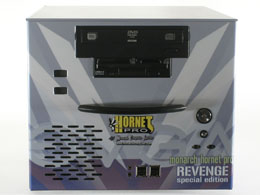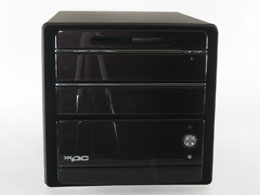Exclusive: SLI Head-to-Head: Monarch Micro-ATX vs. Shuttle SFF
by Jarred Walton on March 6, 2006 8:56 AM EST- Posted in
- Systems
Introduction
There are as many different philosophies on what goes into the creation of an ideal computer as there are individuals in the world. They range from "whatever my friend tells me" to "the best performance money can buy." While the merits of the individual philosophies can be debated ad nauseum, that is largely a fruitless endeavor. People like what they like, and that's perfectly okay as far as we're concerned. What we're here to look at today are a couple of systems that satisfy the desire for maximum gaming performance in the smallest space possible. Yes, we're talking about Small Form Factor systems, though this time, with a slight twist.
The twist comes in the inclusion of a system that isn't a Small Form Factor design in the strictest sense of the word. We have the latest Shuttle SN26P SLI-capable unit, and we also have Monarch Computers' latest foray into the small computer world, the Hornet Pro SLI Revenge. Both are quite a bit smaller than your typical mid-tower ATX case, but where the Shuttle is targeted primarily at reaching the smallest size possible while still offering competitive performance, Monarch goes with a micro-ATX (uATX) form factor. In exchange for size, you get some other options, which we'll discuss more during the course of this review.
There are quite a few items to discuss with both systems, but we've already covered much of the information on the Shuttle in our look at the SN25P. If you're unfamiliar with the Shuttle P chassis, you will find it helpful to read that review first, as we will mostly focus on what changes are present in the SN26P rather than repeating all of the previous material. We'll start by looking at the Monarch Hornet design and then we'll compare that to the Shuttle SN26P and look at the different philosophies. We'll also have our typical battery of benchmarks to show whether or not these diminutive cases really can hang with their bigger brother ATX cases, particularly when SLI is added to the equation - we've shown in the past that SFFs don't have to give up anything in the way of performance, but until recently, dual GPUs have been a feature reserved for the highest-end ATX systems.
There are as many different philosophies on what goes into the creation of an ideal computer as there are individuals in the world. They range from "whatever my friend tells me" to "the best performance money can buy." While the merits of the individual philosophies can be debated ad nauseum, that is largely a fruitless endeavor. People like what they like, and that's perfectly okay as far as we're concerned. What we're here to look at today are a couple of systems that satisfy the desire for maximum gaming performance in the smallest space possible. Yes, we're talking about Small Form Factor systems, though this time, with a slight twist.
 |
 |
| Click on images to enlarge. | |
The twist comes in the inclusion of a system that isn't a Small Form Factor design in the strictest sense of the word. We have the latest Shuttle SN26P SLI-capable unit, and we also have Monarch Computers' latest foray into the small computer world, the Hornet Pro SLI Revenge. Both are quite a bit smaller than your typical mid-tower ATX case, but where the Shuttle is targeted primarily at reaching the smallest size possible while still offering competitive performance, Monarch goes with a micro-ATX (uATX) form factor. In exchange for size, you get some other options, which we'll discuss more during the course of this review.
There are quite a few items to discuss with both systems, but we've already covered much of the information on the Shuttle in our look at the SN25P. If you're unfamiliar with the Shuttle P chassis, you will find it helpful to read that review first, as we will mostly focus on what changes are present in the SN26P rather than repeating all of the previous material. We'll start by looking at the Monarch Hornet design and then we'll compare that to the Shuttle SN26P and look at the different philosophies. We'll also have our typical battery of benchmarks to show whether or not these diminutive cases really can hang with their bigger brother ATX cases, particularly when SLI is added to the equation - we've shown in the past that SFFs don't have to give up anything in the way of performance, but until recently, dual GPUs have been a feature reserved for the highest-end ATX systems.










13 Comments
View All Comments
JarredWalton - Monday, March 6, 2006 - link
HDCP support is a graphics/display issue. As has been reported, HDCP is not supported on any current retail graphics cards. It's also not supported under Windows XP. We should start seeing HDCP enabled cards (meaning, with the necessary decryption chip) in the near future. The GPUs are ready, but they still need the appropriate chip soldered onto the boards.Personally, I'm really not happy with HDCP at all, so I'm doing my best to avoid it. 1280x720 DivX looks quite nice and runs flawlessly on current hardware. Here's an example from the olympics (18GB compressed to 4.5GB 1280x720):
http://images.anandtech.com/reviews/multimedia/tvt...">2006 Olympics Men's Hockey Gold Match
AGAC - Tuesday, March 7, 2006 - link
Hey, what's to love about HDCP. That said, it seems that we just will have to swallow that frog... I mean, DivX does look nice indeed. The problem is availability of mainstream content. I think it's going to be a very cold day in hell before you can walk in the regular video rental and get the latest blockbuster title in beautiful DivX 1280x720.DHCP will be broken, we all know that. It only harms the legal user because one will have to upgrade video cards, monitors and god knows what more will not be HDCP compliant. Thanks for the your tip and simpathy. Keep up the good work.
AGAC
DigitalFreak - Monday, March 6, 2006 - link
NT